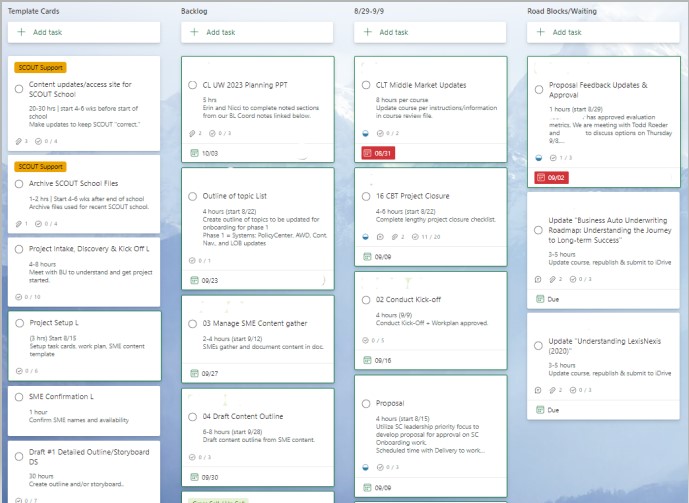Picture it. You are a leader within a Fortune 100 learning and performance organization. The new strategic direction is to become more "Agile," and you are tasked with transforming your instructional design team of 50 associates from a lean, mean, linear design machine to an iterative project management mechanism. It is possible to move from ADDIE to Agile?
My organization’s journey began with a word, a concept, and a book. We failed forward by assuming that our instructional designers would only need a book to learn about Agile and a pilot team to coach and socialize Agile methodologies throughout our department. Due to various levels of professional efficacy, mid-level management, and associate buy-in, this plan did not work.
However, I’m here to tell you that Agile project management within the instructional design space does work.
In 2021, my team of 11.5 associates carried over 20 projects; this year we are slated to carry over zero projects. Between Q1 and Q2 of this year, we completed all 21 of the projects forecast for this time period. And all were delivered on time and within budget. We increased our velocity (efficiency) by 35% between Q1 and Q2 of 2022.
My goal is to share with you our lessons learned in hopes that your learning organization will be better equipped to make a sustainable and impactful change.
Chart your direction
Our leadership team was not aligned or bought into moving from a waterfall design approach to an Agile project management framework. This misalignment lost us two years of actualized productivity. To avoid this:
- Know your why. Take time to align your strategic goals and priorities with why you are making this change. Dig deeper than ‘we are going to gain 10% efficiencies by the end of the year.’ Associates want to know how this change is going to make them better at doing their job today; get granular.
- Chart out your change management plan. Depending on the size of your organization you could use Davenport’s Business Process Re-Engineering model or John Kotter’s Eight-Step Model of Organizational Change model.
- Analyze the skills and capabilities within your leadership group and associates. Determine the baseline standard of work and address how you will upskill, reskill, and train the associates who are below the baseline.
- Risk tolerance. Part of the Agile ceremonies includes retrospectives; retrospectives are huddles or meetings where you discuss your lessons learned from a sprint cycle. As a leadership team, you will decide how comfortable you are with failing forward; low, moderate, or high. And translate your risk tolerance level in terms of productivity, utilization percentages, hours, or weeks. In the beginning, it took our teams at least eight sprints (two-week intervals) to self-team. That means very little work was completed in those two months. However, if you plan and follow steps one through three, then it’s likely your team can be up and running in two weeks.
Tools and technology
This section is the foundation on which you will be able to evaluate and measure the progress of your team, track capacity and forecast resources, and show the impact this transition is making on your organization and customers/clients.
Data mapping
Our instructional design team did know how to consistently track or allocate design hours to their projects. We were tasked with providing data that depicted productivity and utilization to help balance capacity and forecast resources for incoming projects.

Our data capture five status categories: My Time (PTO), Project, Professional Development, Non-Project, and Business Liaison time. Within the Project status function, the instructional designer will allocate time according to the ADDIE phases. Why? From a leader's perspective, this information helps me coach my associates on time management (productivity). I can quickly see where my associates spend the majority of their time in the design phase, and I can ensure that my team is meeting the 68% utilization expectation.
Project management tools
We gave autonomy to our instructional designers to choose which project management tool they wanted to use: Jira or Planner. Our clients submit learning requests through our Nintex intake form, and the content is housed on our SharePoint site.

We were headed in the right direction by using Nintex as a two-in-one intake and project log. We went off the rails with allowing autonomy by using Jira or Planner. I’ll fast forward and suggest that you use Planner if you do not have a software IT SCRUM Master running your projects. It’s easy, the learning curve is low, and you can easily add labels to help you with the reporting function of Planner.
Outline your 'Agile' workflow
Decide how you want the projects to flow through your department. For example, I currently have a team of 11.5 associates. I run three squads: one for my personal line’s business, the other for commercial lines. And, the third is working on a year-long onboarding curriculum. I have two business liaison who act as the relationship and project managers for our clients. An intake is received, and the manager reviews it and sends it to the business liaison. The business liaison schedules the discovery meeting and starts to complete the first two sections of the project log. After analysis work, the business liaison presents learning recommendations to the business unit, and a decision is made to accept the project. The squad is now working iteratively. The squad is split between designers and developers (multimedia specialists). The designers analyze, design, and develop the storyboard and then hand it off to the developers. In between these actions, there are sprints; within each sprint, tasks are completed. This cycle continues until the product is delivered to the client.
Forming & storming
Decide the roles and responsibilities of your instructional design team. What role will the manager and instructional designers play when interacting with the client and managing the workload? How will your instructional design team engage with the trainers, SMEs, and learning technology specialists? What type of outputs are you expecting to see from your team? Learning proposals, outlines, storyboards, prototypes A, B, or C for development work? All of these questions are important to answer before you lead your organization through this change.
Ignite
Once you’ve answered these questions, you are ready to transform your learning organization into a lean, mean Agile team. Remember to inspect what you expect you need to know what you are inspecting. Leaders must understand the framework of Agile, so when your team is moving in the wrong direction you can shepherd them back on track.
If you do not have a strong leader with an instructional design background, it’s well worth the cost to invest in the two-day Agile Project Management certificate offered through TorranceLearning. You will actualize a soft return on investment within the first year of implementation.
Most importantly, create a safe space to fail forward. We are not saving lives, but we are building confidence and competency in our learners. If we allow them to fail and learn, we need to give ourselves the same permission. Good Luck! And know that it’s well worth the effort.
Learn more
Megan Torrance will lead the Agile Project Management Certificate program, a two-day, in-depth workshop on agile project management, at the DevLearn 2022 Conference & Expo in Las Vegas, Oct. 26–28, 2022. Megan Torrance and Amber Boyd will co-present Agile Project Management: Harnessing Change, a concurrent DevLearn session.
For an intro to the ways Agile can transform your learning design, check out the Creating Story for Learning online conference, where Megan Torrance will present “User Stories, Learner Journeys & Other Epic Tales: Decoding Agile & UX Techniques for LX design.” The online conference is Sept. 28–29, 2022. Register today!
Resources
Van Tiem, D. M., Moseley, J. L., & Dessinger, J.C. (2012). Fundamentals of performance improvement: Optimizing results through people, processes, and organizations. San Francisco, CA: John Wiley & Sons, Inc.
Torrance, M. (2019). Agile for instructional designers: Iterative project management to achieve results. Alexandria, VA: ASTD DBA the Association for Talent Development (ATD).



